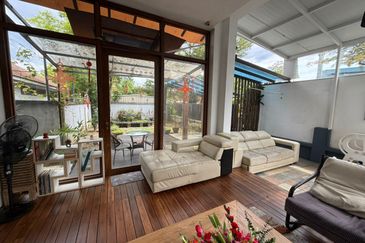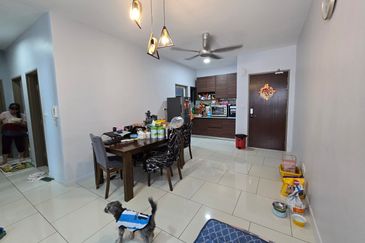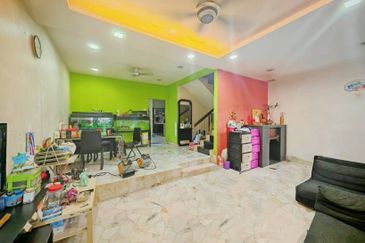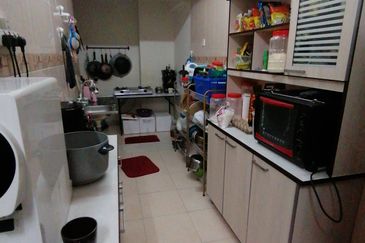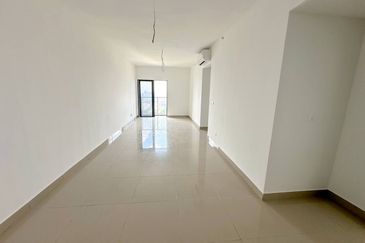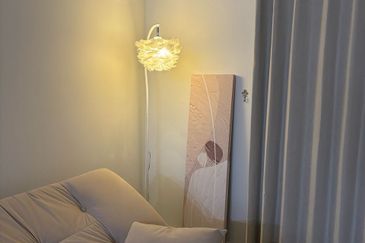The median sale at Kepong, Kuala Lumpur, Malaysia is RM 500,000
Overview
Back in the 1860s, the Kepong area in northwest Kuala Lumpur was a major tin mining area. The tin mining activities led to the formation of a few Kampung Baru (New Villages) that housed a large Chinese population. Today, Kepong remains a township with a predominantly Chinese population.
Situated near the border of Kuala Lumpur and Petaling Jaya, Kepong is strategically located about 12 kilometres from Kuala Lumpur city centre and 10 kilometres from Petaling Jaya.
It is a highly sought-after residential area due to the spreading concept of a balanced lifestyle. Geographically, Kepong is surrounded by 600 hectares of pristine forest land.
High-end enclaves such as Desa ParkCity and Mont’Kiara are located close to Kepong. Other notable residential areas are Taman Bukit Maluri, Kepong Lama, Kepong Baru, Bandar Menjalara, Bandar Sri Damansara and Jinjang.
It is accessible via several highways and main roads such as the Middle Ring Road 2, Lebuhraya Damansara-Puchong, Duta-Ulu Klang Expressway, Jalan Kuching and Jalan Kepong.
There are two train stations on the commuter's Rawang-Seremban route, namely the Kepong KTM station and Kepong Sentral KTM station.
Development boom
In addition to the KTM stations, Kepong’s new property development boom was sparked by the announcement in mid-2016 of the Mass Rapid Transit (MRT) Sungai Buloh-Serdang-Putrajaya Line 2 and that seven of the 26 proposed stations along the route will be located in Kepong, namely Damansara Damai, Sri Damansara West, Sri Damansara East, Kepong Sentral, Metro Prima, Kepong Baru and Jinjang. The line is expected to be completed by 2021 or 2022.
Since 2018, Kepong and its surrounding areas are seeing more redevelopment efforts and new infrastructure, such as the completion of several new highways and road widening projects, hypermarkets and commercial hubs. Newer developments in Kepong are mainly high-rise due to Kuala Lumpur City Hall’s (DBKL) density policy and lack of large tracts of development land.
The demand for residential properties in Kepong comes not only from existing families in Kepong but also new residents who are attracted by its ready amenities and location between Petaling Jaya and Kuala Lumpur city centre. Thus, Kepong’s property market will continue to be supported by its good location.
Amenities and Facilities
Amenities in the vicinity include local and international schools, colleges, shopping malls, hypermarkets – Aeon and Tesco, wet markets in Kepong and nearby Selayang, banks, eateries, restaurants and hospitals (ParkCity Medical Centre). Most of the schools are Chinese schools, bearing witness to it local community. The bustling township has parks and nature reserves, such as the Forest Research Institute of Malaysia (FRIM), Kepong Metropolitan Park in the north of Jinjang and Bukit Lagong Forest Reserve.
Kepong is well known as a food haven for Chinese cuisine ranging from steamboat, bak kut teh, dim sum, be it in stalls in hawker centres to more upmarket restaurants such as Sin Choi Wah Restaurant.
Northern Kepong Poised for rejuvenation (from The Edge Malaysia 11 April 2022 issue)
Kepong, which sits on the border of Kuala Lumpur and Selangor, is an older and more mature neighbourhood in KL. It is densely populated and offers a vibrant mix of residential and commercial developments.
According to Savills (M) Sdn Bhd managing director Datuk Paul Khong, it covers an area of about 4,000 acrees and has a population of 150,000 to 200,000.
As Kepong is a relatively big township, for this update, we focus on northern Kepong, which is bounded by the Middle Ring Road 2 (MRR2), Duta-Ulu Kelang Expressway (DUKE), Selayang-Kepong Highway and Jalan Kuching, and its border with Segambut.
From tin mine to popular neighbourhood
Henry Buther (M) Sdn Bhd chief operating officer Tang Chee Meng says Kepong started off as a tin mining area in 1800s. Some parts were later turned into rubber plantations during the rubber boom. At the height of the tin mining era, many mirgrants from China were brought into work in the mines and till today, Kepong remains a pre-dominantly Chinese neighbourhood.
"During the British Malaya era in the 1950s, Chinese new villages were set up by the British to curb the influence of the communists, and they were established in Kepong too. after independence, the area grew and many new housing schemes were developed to cater for the growing populations," relates Tang.
Khong notes that the northern part of Kepong will see massive changes over the next decade with the developments of new projects by the likes of UEM Sunrise Bhd and Mah Sing Group Bhd. Some are large-scale master-planned products that will change the skyline and enhance the cityscape of the area.
According to Tang, the demand for properties in the area has been encouranging and comparable to that in the neighbouring areas such as sentul, Bandar Sri Damansara, Batu Caves and Taman Wahyu.
Data from Henry Butcher shows that the terraced houses in Kepong Baru, Taman Bukit Maluri, Kepong Garden, Taman Megah, Taman Sri Kepong Baru, Petaling Garden, Taman Fadason, Kepong Entrepreneurs Park and Laman Rimbunan, with built-ups of 847 to 3,165 sq ft, were sold for RM400,000 to RM1.59 million in 2020 and 2021.
During the same period, the semi-detached and detached houses in Laman Residence, Laman Rimbunan and Kepong Garden with built-ups of 2,400 to 4,499 sq ft were transcated at RM1.25 million to RM1.98 million. Rents ranged from RM1,500 to RM3,800 a month, yielding 2.1% to 3.7% a year.
"As for the flats, apartments, condominiums and serviced apartments, they have built-ups of 506 to 2,043 sq ft and were transacted at between RM120,000 and RM763,000 in 2020 and 2021. These units can fetch a monhtly rent of RM700 to RM2,200, which translates into gross return of 3% to 5.6% a year," says Tang.
As for the commercial segment, he notes that the shophouses, shopoffices, shoplots and office units in Kepong Baru, First Residences, Fortune Court, Fortune Square, Metro Prima, Jinjang Selatan, Pekan Kepong and Rimbunan Avenue with built-ups of 861 to 2,077 sq ft were transacted at RM160,000 to RM2.8 million in 2020 and 2021, while an 8,781 sq ft shopoffice in Medan Niaga was sold for RM6.5 million in 2020. Monthly rents range from RM1,100 to RM6,200, giving yields of 2.7% to 4.7% a year.
The upcoming Putrajaya Line (MRT 2) will be a big game changer as it is expected to enhance accessibility in the area, says Khong. "It will have five stations - Metro Prima, Kepong Baru, Sri Damansara Timur (formerly Kepong Sentral), Jinjang and Sri Delima - located along the main thorough-fare of Jalan Kepong, which connects the Jalan Kuching and Jalan Ipoh roundabout in the east to the Selayang-Kepong Highway in the west. These stations are due to be operational in the second quarter of this year."
This, coupled with the completion of DUKE 2, which will reduce travelling time to the city centre, and changes in the development landscape owning to the sizeable projects, will make Kepong more vibrant and improve demand for new real estate once the pandamic is over, he predicts.
Developments in the area
According to Khong, some of the newer developments in the northern part of Kepong are UEM Sunrise's Kiara Bay, and the recently completed The Henge by Aset Kayamas Sdn Bhd and Mizumi Residences by Wawasan Metro Bina Sdn Bhd.
"The local pent-up demand is strong and the earlier market peaks were core reasons for the excellent sales rates for The Henge and Mizumi Residences. Not many new products were offered for sale in the local market and these projects stepped in to fill the vacuum," he says, adding that Kiara BAy has a competitive edge because it is by a reputable developer, and has comprehensive planning, accessibility and proximity to various amenities.
Tang says recent residential projects in the area are well planned and of better quality, and are affordably priced compared with other established areas like Mont'Kiara and Desa ParkCity. "It also enjoys easy assessibility to Kuala Lumpur, Petaling Jaya and other parts of the Klang Valley via roads and highways such as Jalan Kuching, Jalan Kepong, MRR2, DUKE, the North-South Expressway, Selayang-Kepong Highway and Damansara-Puchong Expressway."
Nearby amenities include shopping malls such as Aeon BIG, AEON Mall Metro Prima and Brem Mall; educational institutions such as SJK(C) Kepong 1, SMK Jinjang and SMK Kepong Baru; recreational parks and nature reserves such as Kepong Metropolitan Park, Forest Research Institute Malaysia and Bukit Lagong Forest Reserve; wet markets such as Kepong Baru morning market; and healthcare facilities such as Hospital Selayang and Klinik Kesihatan Jinjang.
Project completed in 2020 include Mah Sing's last tower at Lakeville Residence, Phase 1 of Residensi Seri Wahyu, Aset Kayamas' The Henge and Block B of The Herz, Asian Pac Holdings Bhd's Fortune Centra and TSI Domain Sdn Bhd's Three 33 Residences.
Some notable ongoing and upcoming projects include Kiara Bay by UEM Sunrise in a joint venture with Melati Ehsan Group, M Luna by Mah Sing, and Lake City by Country Garden Holdings Co Ltd and ParkCity Holdings.
Kiara Bay is a 73-acre intergrated township comprising residential, commercial and retail components, and located adjacent to Kepong Metropolitan Park. Its first phase, Residensi AVA, was launched in November 2019. The project comprises 870 residential units in two 41-storey towers. Tang says that the units with built-ups of 813 to 1,285 sq ft are going for RM560,000 to RM980,000, and are slated for completion in 2025.
The 5.47-acre M Luna, also located next to Kepong Metropolitan Park, will comprise 1,672 serviced apartments in two 57-storey towers. Due for completion in 2024, the units with built-ups of 701 to 1,000 sq ft are priced from RM385,000.
Meanwhile, the 80-acre Lake City - located near the Sri Delima LRT station and Taman Wahyu KTM station - will comprise residential, commercial and retail components. Tang says that its first phase, Aradia Residence @ Lake City, consist of three 43-storey towers with a total of 1,003 serviced apartments. Priced from RM360,000, the units with built-ups of 567 to 1,687 sq ft are expected to be completed next year.
Both Tang and Khong are of the opinion that these new developments have enhanced the built environment and upgraded the image and appeal of the area, moving towards high-rise and high-density strata formats.
"With these developments coming onstream in the future, there will certainly be added pressure on the exisiting road networks and this will lead to a worsening of traffic congestion in the area. As such, some of the roads should be widened and traffic flow at busy road intersections/junctions improved to clear bottlenecks and smoothen traffic flow," Tang suggests.
On a positive note, Khong points out that the completion of new infrastructure such as DUKE 3 and MRT2 will help to ease the situation and spur more development and redevelopment in the neighbourhood.
Promising outlook
Tang says that the quality projects launched in Kepong in recent years has improved in terms of concept, design, landscaping, specifications and price point as developers have made an attempt to upgrade the built environment and overall image and positioning of the area. With these developments, the outlook for the property market in Kepong appears promising in the mid to long term.
Khong opines that newer developments in the vicinity of Kepong Metropolitan Park such as Kiara Bay will continue to improve the landscape and image of the Kepong area over the next decade. Prior to this, projects in the township were generally sporadic and haphazardly developed as smallish, standalone schemes. They were understaken by many small local developers without co-ordination, which did not have a positive impact on the landscape of neighbourhood.
The upcoming MRT2 will also create more buzz in the neighbourhood. Khong foresees improvements as Kepong becomes more strategically connected to major new job centres like Tun Razak Exchange, KL city centre and beyond. This will contribute to more in-migration and indirectly rejuvenate the entire are in the long run from a new redevelopment angle.
"Kepong lies at the fringe of the city centre and is strategically located within the city limits. With substantial improvements from the infrastructure angle, much of the older and blighted areas in the vicinity will be due for some 'highest and best use' redevelopment," adds Khong.
For more information on Kepong, check out the following stories:
Properties for sale in Kepong
See All (1310)Properties for rent in Kepong
See All (327)Past Transactions
| Project / TownShips | Type | Median Price Psf | Median Price | Filed Transactions |
|---|---|---|---|---|
| Desa Aman Puri | Condominium/Apartment,Flat,Terrace House | RM 285 | RM 242,404 | 277 Transactions |
| Kepong Baru | Detached House,Semi-Detached House,Terrace House | RM 401 | RM 695,474 | 113 Transactions |
| Taman Bukit Maluri | Terrace House | RM 353 | RM 749,442 | 86 Transactions |
| Puncak Desa | Condominium/Apartment,Flat | RM 272 | RM 243,758 | 66 Transactions |
| Fortune Avenue | Condominium/Apartment,Hotel/Service Apartment | RM 429 | RM 516,365 | 62 Transactions |
| Taman Fadason | Condominium/Apartment,Flat,Hotel/Service Apartment,Terrace House | RM 291 | RM 290,365 | 57 Transactions |
| Mutiara Magna | Condominium/Apartment,Flat | RM 256 | RM 169,219 | 55 Transactions |
| Taman Pusat Kepong | Condominium/Apartment,Flat | RM 209 | RM 183,440 | 41 Transactions |
| Taman Kepong (Kepong Garden) | Detached House,Semi-Detached House,Terrace House | RM 450 | RM 738,237 | 38 Transactions |
| Greenview Apartments | Condominium/Apartment,Flat | RM 220 | RM 181,969 | 36 Transactions |
Check out all transactions.
Rent and Sale Prices in Kepong
| Bedrooms | Sale Price | Monthly Rent | Rental Yield |
|---|---|---|---|
| 1 | RM 653,000 | RM 1,943 | 3.57% |
| 2 | RM 431,560 | RM 1,600 | 4.45% |
| 3 | RM 422,636 | RM 1,419 | 4.03% |
| 4 | RM 666,585 | RM 1,786 | 3.22% |
| 5 | RM -- | RM -- | -- |
Price per Square Foot
| Sector | Price Psf (Non Landed) | Price Psf (Landed) |
|---|---|---|
| Area Average | RM 247 | RM 394 |
| State Average | RM 476 | RM 510 |

